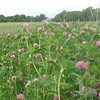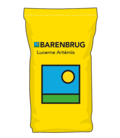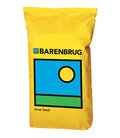Advantages of baled silage
A key benefit of adopting baled silage as a full or part approach is that it can offer flexibility where other methods can’t, as Mhairi Dawson from Barenbrug explains.
“In exceptional growing seasons when clamps are full towards the end of the year, producing baled silage on the last cut could be a valuable preservation method and offer flexibility throughout the winter.
“It also offers the option to easily target smaller fields, for example if a grazing rotation has been allowed to become unpalatable and needs to be removed. Farmers can make decisions about what type of product to produce and if haylage is the best alternative.”
The flexibility of the bale is one of its key attributes and can have extra uses or bring in additional revenue to the farm if there is surplus silage.
Mhairi Dawson continues: “Baled silage as opposed to pit stored silage is easily transportable, so can be sold on if surplus to requirements. It can also be used for other farm enterprises, such as feeding beef or sheep to help reduce bought-in feed costs if the quality is good enough.”
Dry matter (DM) content is still a key driver for achieving quality baled silage and farmers should be clear in what level they are targeting, and why. Peter Smith recommends that farmers in control of their own operation should focus more on cutting grass at the optimum stage to achieve quality forage, rather than completing harvest in the quickest time or prioritising other jobs.
“Although 35-45% DM is usually considered ideal for baled silage, dairy farmers shouldn't be afraid to take bales a little wetter – to both cut wilting times and reduce in-field nutrient losses and thereby produce a better-quality product. Shorter wilting times also make it easier to get the job completed in catchy weather.”
Sward management
Although the process of harvesting the cut grass is different for baled and clamped silage, the principles of maintaining and managing a healthy sward and ensuring the correct nutrient balance in the soil, remain key factors. Mhairi advises that farmers shouldn’t make excuses that big bales are a random decision, so it is impossible to plan for them.
“Healthy soils and swards are essential factors to influence forage quality, no matter how the grass is harvested, and regardless of if the intention at the outset was making baled silage. Good quality grass gives farmers options, whereas poor grass offers fewer alternatives.
“Farmers should be aware that the inclusion of species such as lucerne and red clover are prone to getting stronger and woodier if left too long. If these are in the sward, they should be cut as early as possible and have extra plastic applied to prevent spoilage due to the bales bursting.
“There should also be awareness around phytoestrogen content in any red clover silage bales if they are planned to be fed to sheep. These should not be fed six weeks before tupping and left until six weeks after, to prevent poor conception rates.”
Peter Smith says that bales should be treated as mini clamps and not a “Cinderella” forage product, so the attention to detail that goes into producing them should be no less than for conventional or multi-cut silage.
“Farmers wouldn’t harvest older, more lignified grass and add it to a clamp, so why do it for bales? Indeed, the quality potential of bales can actually be higher than clamped silage if you have your own baling machinery because grass can be cut at its nutritional peak rather than waiting for a contractor. With all silage-making approaches, capturing the most nutritious grass that you can and locking in the valuable nutrients it contains are essential,” he adds.
Baler technology
The machinery on offer to produce baled silage starts with the simple, no-frills fixed chamber balers, right up to fancy baler wrapper combination machines with contractor spec outputs and variable chambers for increased compression and different bale sizes.
James Hutchinson from Kuhn Farm Machinery, says that the wide variety of machinery available makes baled silage a popular option for tenant farmers, or larger processors that might want to benefit from multiple silage storage methods.
“While there is a baler on the market for most budgets, running a combination baler wrapper machine has several advantages as a complete all in one process and it will considerably boost output.”
“Film binding is now a popular option on a lot of balers, and by using one type of binding method there is no separation of film and net required when feeding, which reduces time input and means all the film can be recycled uniformly.
“The film binding on the latest Kuhn VBP 3165 now creates a tighter, more compact bale with better protection around the circumference. This oxygen barrier helps improve bale quality resulting in forage with a higher nutritional value,” adds James.
These advances in technology have meant that baling and wrapping in one pass has offered farmers the ability to start the fermentation process quicker, and Peter Smith highlights that the benefits of this shouldn’t be underestimated.
“Modern balers producing a tightly wrapped bale from one machine reduce the amount of air that could potentially get into the bale once it has been formed. Round bales have a large surface area for air to penetrate, and the three inches around their circumference equates to a third of the bale’s total volume, so sealing this as soon as possible is critical,” adds Peter.
Wrapping and storage
There will be plenty of farmers who can’t justify a baler/wrapper combination machine, so choosing the best way to handle bales and whether to wrap them in the field or at the stack is critical, and as Mhairi Dawson advises, wrapping at the stack can have several advantages.
“For smaller producers, it is still preferable to collect the netted bales from the field and then wrap them at the stack as this will be easier for the loader operator. This not only limits the amount of handling needed once the bale is wrapped and avoids damage creeping in, but reduces the disturbance to fermentation,” explains Mhairi.
Although using an additive is more commonly associated with other silage production methods, farmers that are focused on good silage should be looking to treat bales with an additive to preserve quality. Typically, on dairy farms, the type of additive used should be tailored to how soon the bale will be consumed once it’s been opened and therefore how long the silage will be exposed to air for, says Peter Smith.
“If bales are going to be eaten within a day, where there is little chance of aerobic spoilage and heating, then focus on an additive that preserves the bale by improving the initial fermentation. Many farmers in this situation use Ecosyl 100, as they would for clamped silage.
“But if bales are likely to be around two or three days after opening – for example when feeding youngstock or smaller groups of dry cows – then it’s important to not only focus on the initial fermentation but also to tackle heating and spoilage. In these situations consider Double Action Ecobale, which includes two bacteria, one of which is effective at fermenting drier material, but which also contains a feed-approved preservative. Alternatively, consider an additive such as Ecocool, which contains two beneficial bacterial strains, one for fermentation and one to target the yeasts and moulds that cause heating and spoilage.
“As well as additive choice, avoid stacking bales too high to limit damage, which will allow air in and affect the preservation. Level ground is essential and, if possible, stacking bales on their ends prevents too much squashing.”
Beware of bale contamination
Agricultural testing specialist Eurofins Agro UK suggests that bales can be prone to soil contamination, which is evident if the ash content of a forage sample is high.
Eurofins managing director Daniel Robinson says: “Pre-cut dry NIR tests should be carried out to establish sugar levels and nitrate content. During the cutting and baling process soil can be incorporated into the bale which can lead to potentially harmful bacteria being present in the forage.
“This can lead to, among other things, mould and poisonous mycotoxins being fed to cows, so testing the bale is of utmost importance.”
He suggests that a test that provides a true ash content by burning the sample at 550°c is required to remove any doubt.
“Some tests only estimate ash content by using NIR, but we provide a separate ash test to be more accurate. This will prevent contaminated forage from bales being fed out to milkers and means it can be either discarded or fed to other animals.”






